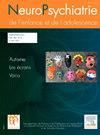对一个多学科协作系统的描述和兴趣,以改善青少年日间医院的药物处方实践
Q4 Medicine
Neuropsychiatrie de l''Enfance et de l''Adolescence
Pub Date : 2025-05-01
DOI:10.1016/j.neurenf.2025.02.007
引用次数: 0
摘要
在几例药物医源性和治疗反应不足的青少年日间医院,对药物处方进行了定量评估。这些数据与关于儿童精神病学中药物使用频率、使用年龄和标签外处方的文献一致,促使该部门在2020年成立了一个工作组来监测药物处方,包括医院和大学中心的药房和药代动力学实验室。这项工作的主要目的是强调如何改善青少年治疗药物相关问题,由于这种多学科的方法,在提出的改进和由此产生的临床效益方面。在实践中,每六个月在日间医院组织一次会议,讨论一两个复杂的情况。医生和护士描述了临床情况并解释了困难。药剂师对处方进行了用药史和深入分析,并提供了良好做法的信息。生物学家分析了血浆药理学分析的结果并提出了建议。也可以对文献进行回顾。医生将这些讨论记录在患者档案中,并让青少年和他或她的法律代表参与会议的结论和由此产生的治疗选择。这种决策辅助意味着一个特定的、合议的反思期可以用于药物处方,它为治疗策略提供了一个更好的框架,特别是在上市许可范围之外。精神药物代谢异常已被确认。这次会议还可以促进新技能的发展。我们建议强调这种工作方法如何有助于提高药物处方的质量、有效性和安全性。本文章由计算机程序翻译,如有差异,请以英文原文为准。
Description et intérêt d’un dispositif collaboratif multidisciplinaire pour améliorer les pratiques de prescriptions médicamenteuses en hôpital de jour pour adolescents
A quantitative assessment of drug prescriptions was carried out in a day hospital for adolescents following several cases of drug iatrogenia and lack of therapeutic response to treatment. These data – which are consistent with the literature on the frequency, age of introduction and off-label prescribing in child psychiatry – prompted the unit to set up a working group in 2020 to monitor drug prescriptions, including the pharmacy and the pharmacokinetics laboratory at the hospital and university centre. The main aim of this work was to highlight the improvements in how adolescents are treated for drug-related problems, thanks to this multidisciplinary approach, in terms of the improvements proposed and the resulting clinical benefits. In practice, a meeting was organised every six months at the day hospital to discuss one or two complex situations. The doctor and nurses described the clinical context and explained the difficulties. The pharmacist carried out a drug history and an in-depth analysis of the prescription and provided information on good practice. The biologist analysed the results of plasma pharmacological assays and made recommendations. A review of the literature could also have been carried out. The doctor recorded these discussions in the patient file and involved the teenager and his or her legal representatives in the conclusions of the meeting and the resulting therapeutic choices. This decision-making aid means that a specific, collegial period of reflection can be devoted to drug prescribing, and it provides a better framework for therapeutic strategies, especially outside the scope of marketing authorization. Abnormalities in the metabolism of psychotropic drugs have been identified. This meeting can also contribute to the development of new skills. We propose to highlight how this working method helps to improve the quality, effectiveness and safety of drug prescribing.
求助全文
通过发布文献求助,成功后即可免费获取论文全文。
去求助
来源期刊

Neuropsychiatrie de l''Enfance et de l''Adolescence
Medicine-Pediatrics, Perinatology and Child Health
CiteScore
0.60
自引率
0.00%
发文量
61
期刊介绍:
Organ of the Société française de psychiatrie de enfant et de adolescent, Neuropsychiatrie de enfance et de adolescence tackles all fields of child-adolescent psychiatry and offers a link between field and clinical work. As a reference and training tool for students and practitioners, the journal publishes original papers in child psychiatry as well as book reviews and conference reports. Each issue also offers a calendar of the main events dealing with the speciality.
 求助内容:
求助内容: 应助结果提醒方式:
应助结果提醒方式:


